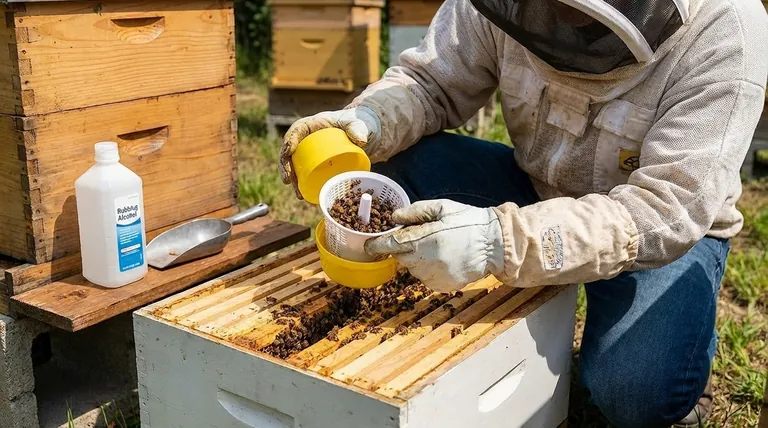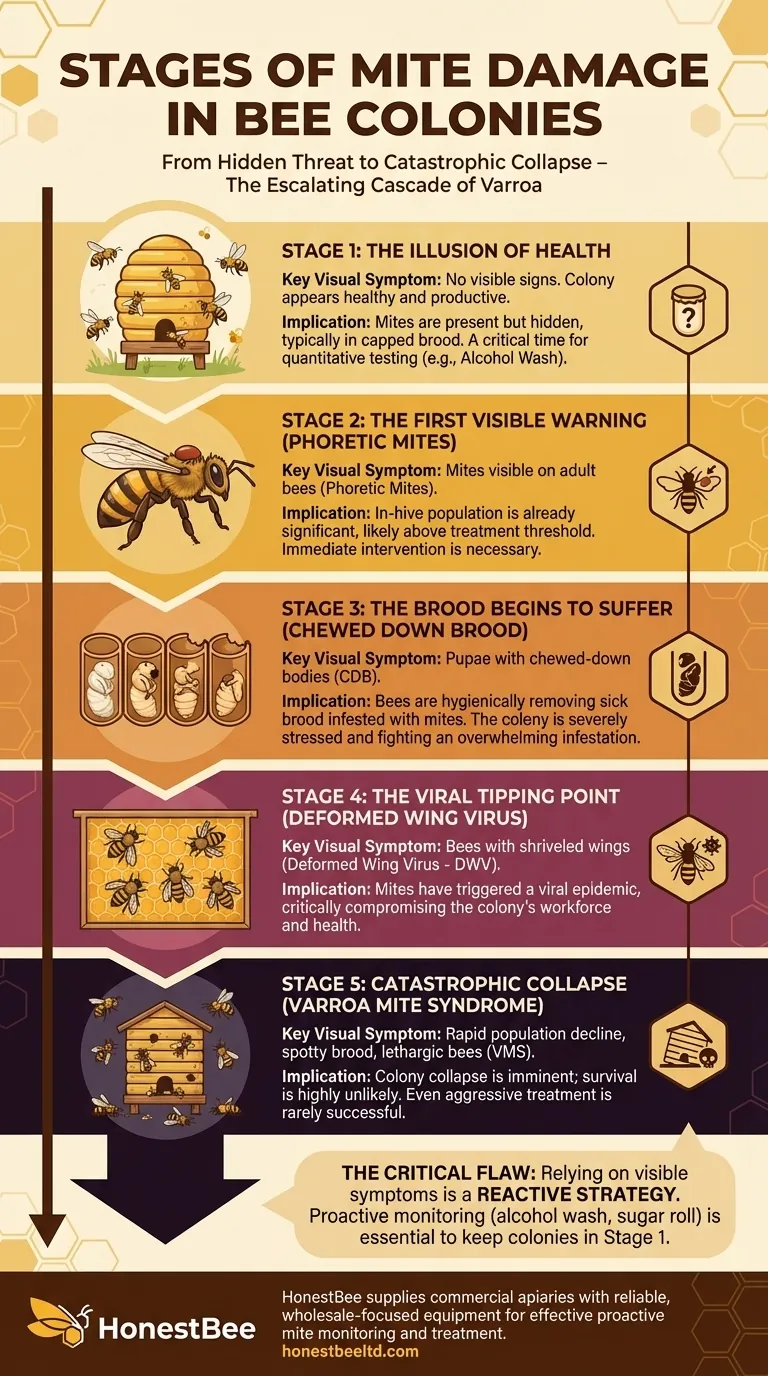In beekeeping, the visible signs of mite damage appear in a predictable, five-stage progression. The stages begin with a seemingly healthy colony (Stage 1), advance to visible mites on adult bees (Stage 2), followed by signs of infected brood (Stage 3), the emergence of mite-vectored viruses like Deformed Wing Virus (Stage 4), and finally, total colony collapse from Varroa Mite Syndrome (Stage 5). Each stage indicates a rapidly escalating mite population that has crossed a critical threshold of damage.
The core challenge for beekeepers is that these visual stages are late indicators of a problem that has already become severe. Effective mite management relies on proactive testing to keep mite levels low, not on waiting for the visible symptoms of colony decline to appear.

The Escalating Cascade of Varroa Damage
Understanding these stages is not just about identification; it's about recognizing a sequence of events. Each stage is a symptom of an underlying cause: a growing population of Varroa destructor mites. As mite numbers increase, they weaken the bees and, more critically, act as vectors for debilitating viruses.
Stage 1: The Illusion of Health
At this stage, the colony appears healthy and productive. There are no visible mites, brood diseases, or viral symptoms.
However, this is the most deceptive stage. A lack of visible signs does not mean a lack of mites. Healthy colonies almost always have a low, manageable level of Varroa. The problem begins when this hidden population starts its exponential growth, typically unseen within the capped brood cells.
Stage 2: The First Visible Warning (Phoretic Mites)
The first clear visual indicator is seeing phoretic mites—small, reddish-brown, oval-shaped parasites—on the bodies of adult worker bees or drones.
"Phoretic" simply means the mites are in a transitional phase, riding on adult bees to move around the hive or transfer to a new host. Seeing even a few mites on bees means the in-hive population is already significant, likely well above the threshold where treatment is necessary.
Stage 3: The Brood Begins to Suffer (Chewed Down Brood)
This stage is marked by Chewed Down Brood (CDB), where you see pupae with their heads or bodies partially chewed away by adult bees.
CDB is a hygienic behavior. The bees can detect that the pupae under the cappings are heavily infested with mites or are sick. They uncap and remove the diseased brood in an attempt to clean the hive. This is a sign that the bees are actively fighting a severe infestation but are likely overwhelmed.
Stage 4: The Viral Tipping Point (Deformed Wing Virus)
At this stage, you begin to see bees with shrunken, shriveled wings, a classic sign of Deformed Wing Virus (DWV).
Varroa mites are the primary vector for DWV. While the virus can exist at low levels in a colony, the mites activate and transmit it when they feed on pupae. The appearance of DWV is a definitive sign that the mite population is high enough to cause a secondary viral epidemic, severely compromising the colony's workforce.
Stage 5: Catastrophic Collapse (Varroa Mite Syndrome)
This final stage is a complete breakdown of colony health, often called Varroa Mite Syndrome (VMS) or Parasitic Mite Syndrome.
Symptoms include a rapidly dwindling population, a spotty and inconsistent brood pattern, lethargic and disoriented bees, and often the disappearance of the queen. The colony is no longer viable and will almost certainly perish, sometimes in a matter of weeks. At this point, even aggressive treatment is rarely successful.
The Critical Flaw of Visual Inspection
Relying on these five stages to manage mites is a reactive strategy that is destined to fail. By the time you can see the problem, the damage is already done.
Why Waiting for Symptoms Is Too Late
The economic and health threshold for Varroa mites is the point at which they begin to negatively impact colony health and productivity. This threshold is crossed long before Stage 2 (visible mites) or Stage 3 (CDB) appears.
Waiting for these visual cues means you have already allowed significant damage to the brood, shortened the lifespan of your adult bees, and unleashed a viral epidemic within the hive.
The Power of Proactive Monitoring
The professional standard for mite management is not visual inspection, but quantitative testing. Methods like an alcohol wash or a sugar roll give you a precise mite count (e.g., mites per 100 bees).
This data allows you to act when mite loads are still low and the colony is healthy. It shifts your role from a medic treating a dying patient to a manager maintaining the health of a strong workforce.
Making the Right Choice for Your Colony
Your goal should be to keep your colonies in Stage 1 indefinitely by using proactive monitoring and timely treatment.
- If you see Stage 1 (no visible signs): Immediately perform a mite count using an alcohol wash or sugar roll to verify the actual mite load and determine if you are below the treatment threshold.
- If you see Stage 2 or 3 (visible mites or CDB): Your colony is under significant stress and requires an immediate, effective mite treatment to prevent it from progressing to the viral stage.
- If you see Stage 4 or 5 (DWV or VMS): The colony's survival is in doubt. While aggressive treatment is the only option, you must be prepared for the colony to fail and take steps to prevent the spread of mites to other hives.
Successful beekeeping is defined by preventing problems, not by reacting to them.
Summary Table:
| Stage | Key Visual Symptom | Implication for the Colony |
|---|---|---|
| 1 | No visible signs (Illusion of Health) | Mites are present but hidden; a critical time for testing. |
| 2 | Mites visible on adult bees (Phoretic Mites) | In-hive mite population is high; immediate treatment is needed. |
| 3 | Pupae with chewed-down bodies (Chewed Down Brood) | Bees are hygienically removing sick brood; colony is severely stressed. |
| 4 | Bees with shriveled wings (Deformed Wing Virus) | Mites have triggered a viral epidemic; colony health is critically compromised. |
| 5 | Rapid population decline, spotty brood (Varroa Mite Syndrome) | Colony collapse is imminent; survival is highly unlikely. |
Don't wait for visible damage to manage mites. Protect your apiary's health and productivity with the right equipment from the start. HONESTBEE supplies commercial apiaries and beekeeping equipment distributors with the reliable, wholesale-focused supplies needed for effective proactive mite monitoring and treatment. Ensure your colonies stay healthy and productive—contact our experts today to discuss your needs.
Visual Guide

Related Products
- Varroa Easy Check Mite Tester Kit Counter Alcohol Wash Jar
- Adjustable Formic and Acetic Acid Dispenser for Bee Mite Treatment
- 12V Bee Mite Removal Evaporator Oxalic Acid Vaporizer for Bee Fumigation Treatment 180W Atomization
- Oxalic Acid Vaporizer 12V for Bee Varroa Mite Treatment
- Durable 12V Oxalic Acid Vaporizer for Varroa Mite Treatment Beehive Beekeeping Tool
People Also Ask
- How often should varroa mite checks be performed using the alcohol wash method? Optimize Your Apiary's Health
- What is the most reliable method for assessing Varroa mite infestations? Master Proactive Hive Management
- What are some popular methods to measure Varroa mite load in beehives? Compare Accuracy & Bee Safety
- What is the Varroa EasyCheck and its purpose? Streamline Your Hive Health Monitoring
- How is the infestation percentage calculated after counting mites? Master Varroa Mite Monitoring



















